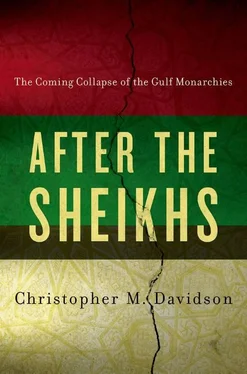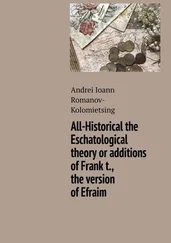96. Kéchichian (2008), p. 206.
97. Hadef Jawan Al-Dhaheri.
98. Sultan bin Said Al-Mansuri.
99. Muhammad bin Dhaen Al-Hamili.
100. Kéchichian (2008), p. 285. As per article 72 of the constitution.
101. Rizvi, S., ‘From Tents to High Rise: Economic Development of the United Arab Emirates’, Middle Eastern Studies , Vol. 29, No. 4, 1993, p. 665.
102. These have normally been over concerns that were already shared by the Council of Ministers, such as the need for tightening anti-drug legislation and the need for further modifying the UAE’s property laws. Al-Nahyan, Shamma bint Muhammad, Political and Social Security in the United Arab Emirates (Dubai: 2000), pp. 122–123.
103. Especially in cases where the FNC’s views were likely to diverge from the relevant minister’s outlook, such as over the price of petrol or the cultural content of terrestrial television. Ibid., p. 121.
104. There have been examples of the FNC’s letters to ministers having remained unanswered for several months, and occasions when the FNC has been unable to persuade ministers to attend their sessions and answer basic questions on their policies. Ibid., pp. 178–179,188.
105. Reuters, 24 September 2011.
106. WAM , 21 June 2011.
107. Reuters, 24 September 2011.
108. Davidson (2009), p. 125.
109. Valeri (2011), p. 140.
110. Valeri, (2011), p. 139; Katz, Mark, ‘Assessing the Political Stability of Oman’, Middle East Review of International Affairs , Vol. 8, No. 3, 2004.
111. Valeri (2011), p. 139.
112. Ibid., pp. 143–144.
113. Ibid., p. 144.
114. Article 6.
115. Valeri (2011), p. 139. Quoting articles 2, 3, 5, 9 and 41 of the 1996 Basic Law of Oman.
116. Davidson (2005), pp. 94–95.
117. Davidson (2009), chapter 4.
118. Dubai’s share is now only 4 per cent, with the remainder being made up of minimal exports from Sharjah, Ra’s al-Khaimah, and Fujairah. Ajman and Umm al-Qawain do not have commercially exploitable oil reserves. Davidson (2009), chapter 4.
119. CIA World Factbook 2009, Economics overviews on Saudi Arabia, the UAE, Kuwait, Qatar, Oman, and Bahrain, 2007 and 2008 estimates. Author calculations for totals.
120. Ibid.
121. Ibid.
122. British Petroleum Statistical Review, June 2008.
123. US Energy Information Administration (EIA). Qatar profile, 2009.
124. CIA World Factbook . People and economics overviews of Japan, China, South Korea, Saudi Arabia, the UAE, Kuwait, Qatar, Oman, and Bahrain. Statistics from 2007–2008, with 2009 population estimates. Supplementary data from the International Monetary Fund, World Bank, and OECD country overviews, 2009.
125. Kuwait News Agency , 15 January 2012. Combined assets are expected to reach $1.9 trillion in 2012.
126. Euromoney , 1 April 2006.
127. Davidson (2009), chapter 4.
128. Davidson, Christopher M. The Persian Gulf and Pacific Asia: From Indifference to Interdependence (London: Hurst, 2011), chapter 5.
129. Van der Meulen, Hendrik, ‘The Role of Tribal and Kinship Ties in the Politics of the United Arab Emirates’ (PhD thesis. The Fletcher School of Law and Diplomacy, 1997), p. 93.
130. Davidson (2009), chapter 4.
131. The Economist , 17 January 2008; Seznec, Jean-François. ‘The Gulf Sovereign Wealth Funds: Myths and Reality’, Middle East Policy , Vol. 15, No. 2, 2008, pp. 97, 101. ADIA was believed to have had $875 billion in assets according to Deutsche Bank. However, Seznec believes the figure to be much lower. But he may have placed insufficient weight on ADIA’s history of investments in emerging markets.
132. CIA World Factbook . People and economics overviews of Japan, China, South Korea, Saudi Arabia, the UAE, Kuwait, Qatar, Oman, and Bahrain. Statistics from 2007–2008, with 2009 population estimates. Supplementary data from the International Monetary Fund, World Bank, and OECD country overviews, 2009.
133. Officially the Investment Corporation of Dubai holds $19.6 billion in assets. 2012 figures.
134. According to Mumtalakat Holdings’ official financial report for December 2011 its total holdings were just over $11 billion. Oman’s State General Reserve Fund is thought to have just over $8 billion in assets.
135. Mansour bin Zayed Al-Nahyan.
136. Quoting official figures for total holdings supplied in 2011 by the Qatar Investment Authority, the Mubadala Development Company, and the International Petroleum Investment Company.
137. Arab News , 5 October 2009.
138. Khaleej Times , 20 December 2009.
139. Coates Ulrichsen, ‘Saudi Arabia’ in Davidson (2011), p. 78.
140. Roberts (2011). p. 102.
141. US Department of State. ‘Background Note: Kuwait’ 2011.
142. New York Times , 28 December 2008.
143. Oxford Business Group , ‘Abu Dhabi: The Report 2007’. p. 202.
144. Also known as Borouge. Oxford Business Group , ‘United Arab Emirates: The Report 2000’. pp. 94–95.
145. Oxford Business Group , ‘Abu Dhabi: The Report 2007’. p. 212.
146. The latter being built at Ruwais in co-operation with Rio Tinto. The National , 24 July 2008; Seznec (2008), p. 101.
147. Borealis press release, 19 March 2008.
148. Gulf News , 1 March 2012.
149. Also known as the Higher Corporation for Economic Zones.
150. Davidson (2009), chapter 4.
151. Gulf News , 1 March 2012.
152. Davidson (2008), chapter 4.
153. Dubai Department for Tourism and Commerce Marketing, press release, 28 February 2011.
154. Abu Dhabi Tourism Authority, press release, 31 January 2011.
Читать дальше












